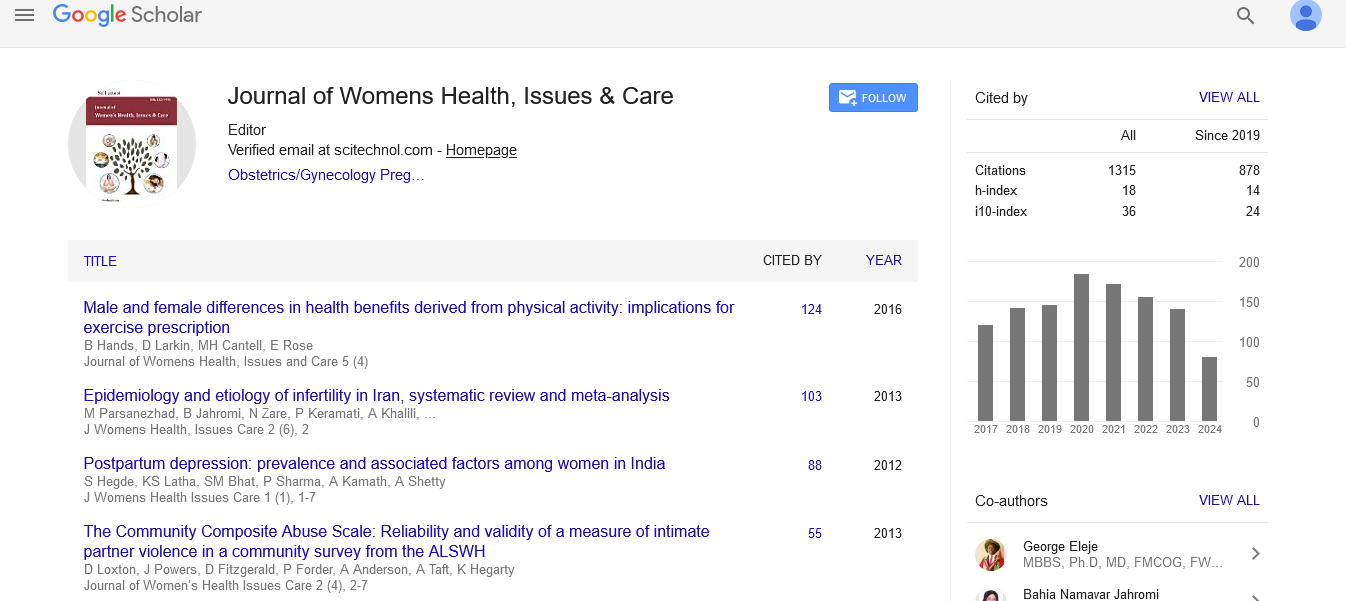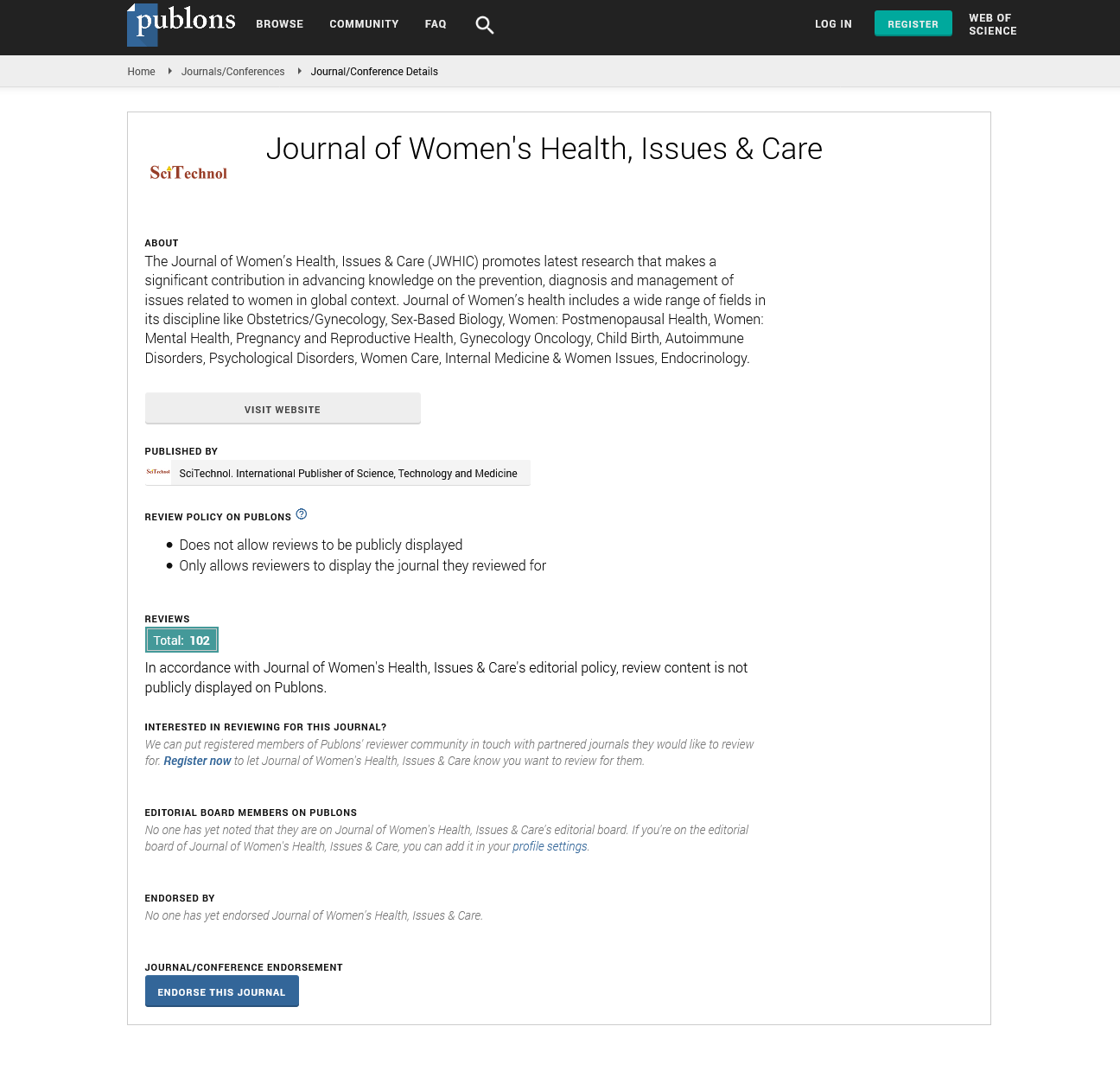Perspective, J Womens Health Vol: 13 Issue: 2
Gestational Diabetes Mellitus: Understanding the Epidemic and Charting Paths to Healthier Outcomes
Nelson Davison*
1Department of Medicine, Perelman School of Medicine at the University of Pennsylvania, Philadelphia, Pennsylvania, USA
*Corresponding Author: Nelson Davison,
Department of Medicine, Perelman
School of Medicine at the University of Pennsylvania, Philadelphia, Pennsylvania,
USA
E-mail: Davison.nelosn@gmail.com
Received date: 27 March, 2024, Manuscript No. JWHIC-24-132534;
Editor assigned date: 29 March, 2024, PreQC No. JWHIC-24-132534 (PQ);
Reviewed date: 12 April, 2024, QC No. JWHIC-24-132534;
Revised date: 19 April, 2024, Manuscript No. JWHIC-24-132534 (R);
Published date: 29 April, 2024 DOI: 10.4172/2325-9795.1000493.
Citation: Davison N (2024) Gestational Diabetes Mellitus: Understanding the Epidemic and Charting Paths to Healthier Outcomes. J Womens Health 13:2.
Description
Gestational Diabetes Mellitus (GDM) is a form of diabetes that develops during pregnancy, characterized by impaired glucose tolerance and insulin resistance. It poses risks to both maternal and foetal health, including complications during pregnancy, birth, and long-term health outcomes for both the mother and child. Despite its significance, GDM remains a complex and often underdiagnosed condition.
Epidemiology of gestational diabetes mellitus
Gestational Diabetes Mellitus (GDM) affects a substantial number of pregnant women worldwide, with varying prevalence rates depending on factors such as age, ethnicity, and Body Mass Index (BMI). Epidemiological studies indicate that GDM rates are rising globally, mirroring the increasing prevalence of obesity and type 2 diabetes mellitus. Certain populations, including older women, those with a family history of diabetes, and certain ethnic groups, such as Hispanic, Asian, and Indigenous women, are at higher risk of developing GDM. Understanding the epidemiology of GDM is important for targeted screening and intervention efforts.
Risk factors for gestational diabetes mellitus
Several factors contribute to the development of Gestational Diabetes Mellitus (GDM), including maternal age, obesity, family history of diabetes, previous history of GDM, and certain ethnicities. Advanced maternal age, particularly over 35 years old, is associated with an increased risk of GDM, as are high pre-pregnancy BMI and excessive gestational weight gain. Women with a family history of diabetes or a previous history of GDM are also at higher risk. Additionally, certain ethnic groups, including Hispanic, Asian, African-American, and Indigenous women, have a higher prevalence of GDM compared to other populations.
Clinical implications of gestational diabetes mellitus
Gestational Diabetes Mellitus (GDM) poses risks to both maternal and foetal health, including complications during pregnancy, birth, and long-term health outcomes. Maternal complications of GDM may include hypertensive disorders, increased risk of caesarean section, and development of type 2 diabetes mellitus later in life. Foetal complications may include macrosomia, birth trauma, neonatal hypoglycaemia, and increased risk of obesity and type 2 diabetes in later life. Early detection and management of GDM are essential for reducing the risk of adverse outcomes for both mother and child.
Screening and diagnosis of gestational diabetes mellitus
Screening for Gestational Diabetes Mellitus (GDM) involves assessing glucose tolerance using various methods, including Oral Glucose Tolerance Tests (OGTT), Fasting Plasma Glucose (FPG) tests, and risk factor assessment. The American College of Obstetricians and Gynaecologists (ACOG) recommends universal screening for GDM at 28 weeks of gestation using a 2-step approach, with an initial Glucose Challenge Test (GCT) followed by a diagnostic OGTT for those who screen positive. Early diagnosis and intervention are important for optimizing pregnancy outcomes and reducing the risk of complications associated with GDM.
Management strategies for gestational diabetes mellitus
The management of Gestational Diabetes Mellitus (GDM) focuses on achieving and maintaining glycemic control through lifestyle modifications, dietary interventions, glucose monitoring, and, in some cases, pharmacotherapy. Lifestyle modifications may include dietary counseling, regular physical activity, and weight management strategies. Medical nutrition therapy aims to achieve adequate nutrition while controlling blood glucose levels through carbohydrate counting, meal timing, and portion control. Insulin therapy or oral antidiabetic medications may be required for women with persistent hyperglycemia despite lifestyle modifications. Close monitoring and multidisciplinary care involving obstetricians, endocrinologists, dietitians, and diabetes educators are essential for optimizing outcomes for women with GDM and their offspring.
Conclusion
Gestational Diabetes Mellitus (GDM) is a significant health concern affecting pregnant women worldwide, with implications for maternal and fetal health. Despite its prevalence and impact, GDM remains a complex and often underdiagnosed condition. By enhancing understanding of the epidemiology, risk factors, clinical implications, and management strategies for GDM, healthcare providers can improve diagnosis, treatment, and ultimately, the health outcomes for women and their offspring. Further research is needed to elucidate the underlying mechanisms of GDM and develop targeted interventions to address this growing public health issue.
 Spanish
Spanish  Chinese
Chinese  Russian
Russian  German
German  French
French  Japanese
Japanese  Portuguese
Portuguese  Hindi
Hindi 



